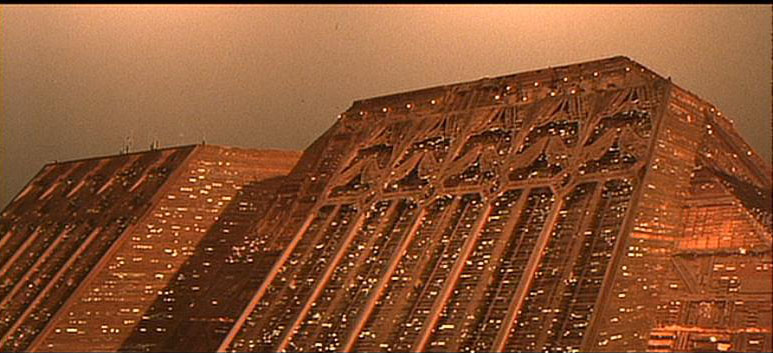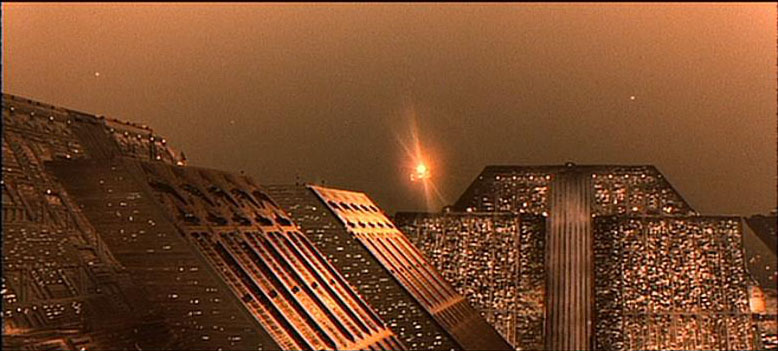




Fifty five years after Lang's Metropolis it's influences can still be seen in Ridley Scott's 1982 film Blade Runner, like Lang, Scott "depicts the road we're heading down new class separation, the growing gulf between rich and poor, the population explosion - and it offers no solutions" (Webb 44). Scott's metropolis is the future Los Angeles, and like Lang's 1927 Metropolis the film design development team found there inspiration in New York City, as described by the effects supervisor Douglas Trumbull;
"Our biggest challenge was to develop a sense of immense scale the idea of having something like New York with a lot of fifty or sixty storey buildings that are part of the landscape and then above that these mega structures the occupy several blocks and go up many hundreds of stories." (Webb 46)
The result was a visually dense urban environment that not unlike Lang's urban landscape the future Las Angles was also dominated by a modern corporate temple, the Tyrell Headquarters. The Tyrell Headquarters is monumental in scale with two huge buildings, the tallest being seven hundred stories tall, and six city blocks deep. Introduced in the first shot, a fly through, Los Angeles has become an industrial zone, the powerful imagery has huge towers spouting flames into the darkened sky, and beyond is the Tyrell Headquarters; two flat topped pyramids alive in the night sky with thousands of tiny sparkling lights.
The pyramids are so massive that they are in distinguishable for their surrounding, like Metropolis they can only be viewed in aerial shots and fly thoughts, the scale is based on New York as described by Syd Mead production designer,
"I took the two World Trade Towers in New York City and the New York street proportions as a today model and expanded everything vertically about two and half times. This inspired me to make the bases of the building sloping to cover about six city blocks. On the Premise that you would need move ground access to the buildings base." (Neumann 152)
Similar to Lang's approach of playing on the audiences fear, Scott plays on the audiences naïve unbroken faith in technology, belief in apparently seemingly unlimited resources, and unlimited room for growth. He creates a vision of a city that is created through a layering of information and perceptually overloading the viewer, with an overlying of various types of architectural typologies including the pyramid, skyscrapers, intermingled with urban debris from the past.
In the simplest sense Scott's film draws on the medieval cosmology and hierarchy of the universe with heaven above and hell below. The ground level of city has been relinquished to disorder by poisonous smog, acid rain and a constant foggy mist, those whose could afford to leave the city have gone to elite off earth colonies, while earth is populated by ethnic lower classes. The top offices of the Tyrell Headquarters is the only place that receives natural light, the upper most office is occupied by Dr. Elden Tyrell, his huge office with it's temple like qualities. The columns of the office and its layout are reminisce of the Egyptian temples of the XII Dynasty, those temples created between 1991 - 1786 BCE. The large columned halls followed by sanctuary, in the case Tyrell's living quarters, the main difference is that rather than looking inwards into a lit courtyard, Tyrell's office faces outwards overlooking the city bathed is a soft yellow glow.
Tyrell Corporation is a powerful monopoly that gained its wealth and power from manufacturing replicants to server as slaves in off world colonies, these replicants are said to be 'more human then human.'(Blade Runner 1982) The theme of God, the creator and created can be seen through this film, for the most part these references are biblical in nature. Before killing Tyrell, Roy the replicant whom Tyrell refers to as 'the prodigal son' (Blade Runner 1982), places his two hands on Tyrell's cheeks and kisses him passionately on the lips, a reference to Jesus betrayal with a kiss in the New Testament. Tyrell as god is easily translated into an architectural typology. The pyramid in the most traditional sense is a place where the pharaoh, the living god, is placed after his death and absorbed into immortality. The physical manifestation of the pyramid is monolithic and immutable; similar to ancient Egypt, immortality in Blade Runner is reserved for the elite few. Tyrell seems to fall easily into the role of God; although he himself may not be immortal his architectural presence in the urban fabric will transcend generations and in a sense making him immortal.




